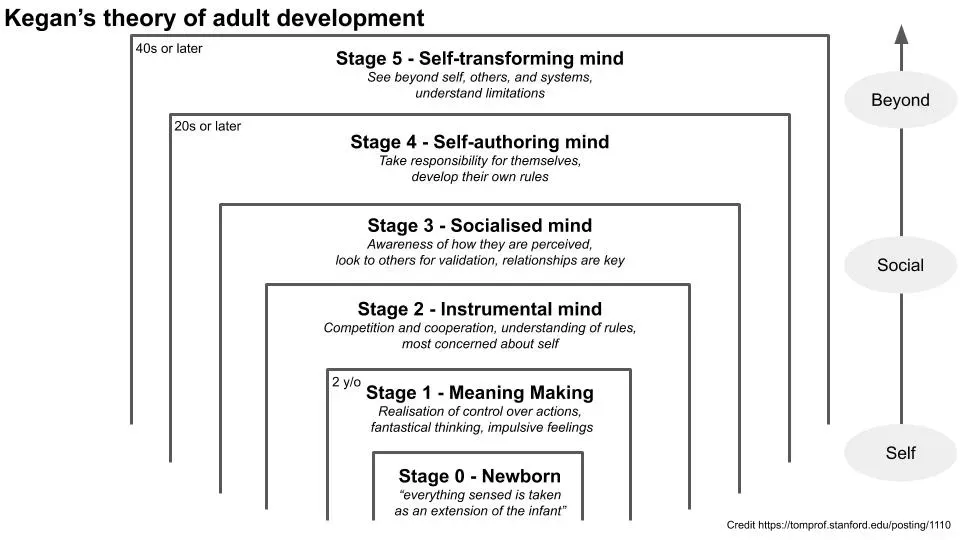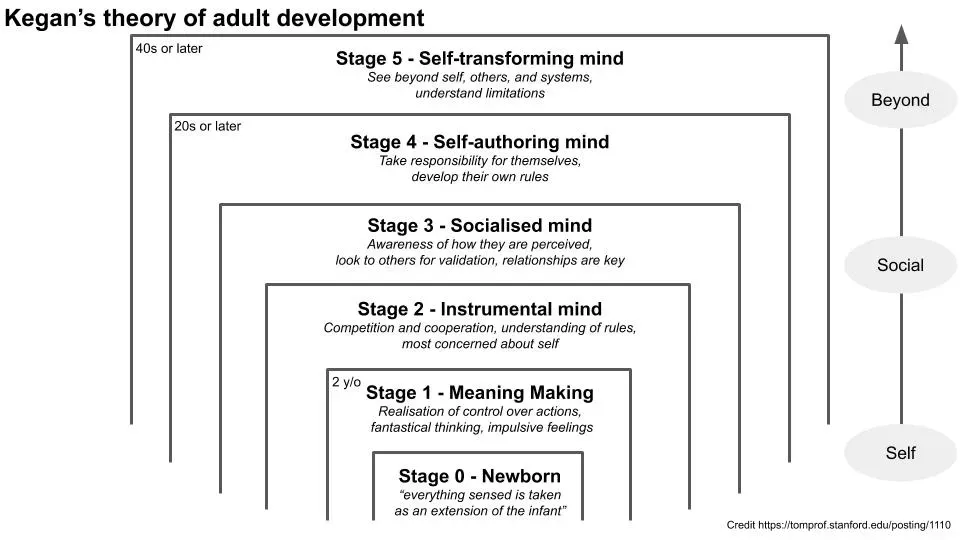What is art
Different definitions of art over history

Kegan’s theory describes how we can continue to grow as adults and reach our fullest potential.
Imagine a caterpillar that dies before it changes into a butterfly. Or a larva before turning into a ladybug. We’d think it was a shame that these never reached their full potential. Just like a caterpillar is not meant to die as a caterpillar, Robert Kegan believes adult development theory can help us better understand how to reach our fullest potential.
I’ve briefly mentioned Robert Kegan’s theory of adult development before here, and recently I found an online Stanford post that discusses the concept in more detail than what I’d seen on wiki 1. Kegan’s theory describes how we can grow and become more complex as we age, even as adults 2. Highlights below, and I’ll be paraphrasing or outright lifting from the article.
Historically, people believed that a person’s development peaked after the adolescent stage, having grown through being an infant and a child. Kegan disagreed, and believed we continue growing psychologically past adolescence. He proposed that growth of an individual moves through five stages. He uses different terms for these, depending on the year he writes about them 3, and I’ll use “stage of development” for the rest of this post for consistency. The process of moving from one stage to another can be painful, as we integrate more awareness of the world into our own logic.
The five stages he proposes, after an initial “newborn infant” stage 4, are:
“Parents should support their children’s fantasies while challenging them to take responsibility for themselves and their feelings as they begin to perceive the world realistically and differentiate themselves from others”
Instrumental mind. Thinking becomes more realistic and logical, and the dominance of feelings declines. Children start understanding rules and how their lives are structured. They start to better understand who they are and what they want. They also start understanding how to compete and how to cooperate. They are mostly concerned about themselves, and find it difficult to consider how their actions will affect others.
Kegan gives an example of a would be car thief refraining from stealing because she was worried that she would be sent to jail if she got caught. It would be better if she didn’t steal because it was the right thing to do, but she’s not there yet in terms of stage of development.
Socialised mind. People start becoming aware of how others think of them, and strive to be perceived well by others. They look to others for validation and direction. They act in ways that consider how other’s view of them might change. Relationships are the most important thing. This is the start of a more “adult” stage of development.
If you’ve ever made a decision because it might please others or because you thought they wanted you to make that choice, this is the stage of development that guides that.
Self-authoring mind. People now take responsibility for themselves, and develop their own systems on what they feel is right. They no longer depend on others for validation, but can get satisfaction by themselves. Relationships are part of them rather than dominating their purpose.
Kegan believes this doesn’t usually happen until your 20s, and some people might never reach this stage. The article cites research (small sample size warning) in showing that the majority of adults interviewed are not at this stage 5. It is a gradual but the most dynamic change in development to move from “socialised” to “self-authoring”
Self-transforming mind. People see beyond themselves, others, and their system. They recognise the shared features of the systems they and others live in, but also the limitations. They are able to critique the systems and adjust them over time.
Kegan believes people don’t reach this before their 40s, and most people never reach this stage at all. An example would be how society or individuals started realising in the importance of some laws such as equal rights

Now that we know of Kegan’s framework, we can apply it both to ourselves and in our relationships with others. The implicit assumption is that we should all strive towards higher stages in our development, though it’s a personal choice to accept this framework as “true” or not 6. Kegan encourages people to think for themselves, saying that everyone has their own hierarchy on what they believe to be superior.
People are comfortable with hierarchic notions of how children construct reality, but when you start introducing the same idea into the realm of adulthood, it’s understandably provocative
In terms of relating to others, Kegan’s framework is useful both in school and at work. Teachers are often at a level 4, and expecting their students to have the same independent mindset, whereas most of the time students are still struggling at level 3. This causes frustration on both sides when expectations don’t match.
To help bridge this gap, another researcher, Michael Ignelzi, suggests doing the following: (1) value and support students’ current ways of thinking, (2) provide structure and guidance in taking on unfamiliar tasks, (3) encourage students to learn from each other by working together in groups, and (4) acknowledge and reinforce students’ successes in moving to a self-authored perspective while recognizing the challenges required to do so.
At work, supervisors need to provide their supervisees structure and support to reach for level 4 self-authorship and independence, rather than leaving them to just be looking towards others for instruction at level 3. This is usually difficult as well, since it requires both parties to realise the existence of such developmental levels, and also agree that level 4 is better than level 3, which can be controversial.
I believe someone posted about it on twitter, but can’t find the original tweet. If this was you, lmk and I can credit accordingly. ↩
“Kegan (Robert) introduced his theory of self-evolution in 1982 in his book, The Evolving Self. In his later book, In over Our Heads: The Mental Demands of Modern Life (1994), he presented a revised version of his theory and further discussion of the implications of his work for society.” He was influenced by Piaget and Kernberg. ↩
“Kegan referred to as stages of development in 1982, orders of consciousness in 1994, and forms of mind in 2000” ↩
Kegan has a stage 0, where he “described newborn infants as “living in an objectless world, a world in which everything sensed is taken to be an extension of the infant” (p. 78). As a result, when the infant cannot see or experience something, it does not exist ↩
“A four-year longitudinal study of twenty-two adults conducted by Kegan, Lahey, Souvaine, Popp, and Beukema using the Subject-Object Interview (Lahey, Souvaine, Kegan, Goodman, & Felix, 1988) revealed that “at any given moment, around one-half to two-thirds of the adult population appears not to have fully reached the fourth order of consciousness” (Kegan, 1994, pp. 188, 191). Drawing on thirteen other studies conducted mainly by his doctoral students, Kegan (1994) reported that in the composite sample of 282 relatively advantaged adults, 59 percent had not reached the fourth order.” ↩
Is questioning his system a level 5 effort? ↩
Get my next essays in your inbox:
Comments